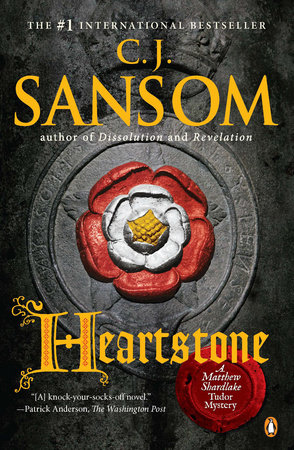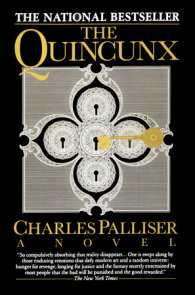READERS GUIDE
Questions and Topics for Discussion
INTRODUCTION
Set during the reign of Henry VIII, Heartstone plunges readers into the tumultuous world of Tudor England—a world of war, poverty, court intrigue, deception, greed, murder, class strife, and fierce legal battles. Lawyer Matthew Shardlake is given a complicated case by Bess Cahill, a faithful servant of Queen Catherine Parr, to discover why her son Michael committed suicide, and to investigate Michael’s charge that a horrible wrong had been inflicted on two young wards for whom Michael was a tutor.
Shardlake and his assistant Jack Barak set out for Portsmouth, a week’s ride away, to visit the family of the newly wealthy landowner Edwin Hobbey, who had taken charge of the wards, Emma and Hugh Curteys. The case proves frustrating and mysterious for the investigative duo as they discover that Emma died of smallpox and Hugh Curteys has no complaints about his treatment. But Shardlake senses that all is not what it seems and that the family is harboring a dreadful secret, and he will not rest until he ferrets it out.
Shardlake makes matters even more complicated by probing into the strange circumstances which led, nineteen years before, to a seemingly sane woman being sent to Bedlam, London’s asylum for the insane. He has befriended the woman, Ellen Fettipace, and feels compelled to uncover what led to her incarceration and who is paying her fees. Shardlake suspects it was rape that pushed Ellen to insanity, but his investigation uncovers an even more sinister crime at the heart of Ellen’s story.
The year is 1545 and England is readying itself for an attack by a vastly superior French fleet in retaliation for King Henry’s disastrous war on France in 1544. As Shardlake pursues his investigations in Portsmouth, he finds himself aboard the great warship the Mary Rose as it comes under fire.
But Heartstone is as much about the Tudor period as it is about the cases Shardlake is trying to solve. The novel reveals many aspects of the age: the corruption that plagued the Court of Wards, where orphans were often shamelessly exploited; Henry VIII’s megalomaniacal preparations for war; the confiscation of monastic lands; and the greed, snobbery, and arrogance of the aristocracy.
Shardlake is the novel’s moral center. And while he’s not the naive idealist Richard Rich makes him out to be (Shardlake is capable of lying and cutting a deal when it serves his purpose), he is most certainly a man relentless in his pursuit of truth, fairness, and justice, regardless of the consequences. Rich argues that “Those with conscience are too obsessed with the rightness of their cause to survive, in the end” (p. 547). Shardlake is powerfully obsessed with the rightness of his cause—no one, including Shardlake himself, would argue against that view—but so far, and just barely, he manages to survive.
ABOUT C. J. SANSOM
After a career as an attorney, C. J. Sansom now writes full time. Heartstone is his fifth Matthew Shardlake mystery.Dissolution, which P. D. James picked as one of her five favorite mysteries in The Wall Street Journal; Dark Fire, winner of the CWA Ellis Peters Historical Dagger Award; Sovereign; and Revelation, a USA Today Best Book of the Year for 2009, are all available from Penguin. Sansom is also the author of the international bestseller Winter in Madrid, a novel set in the aftermath of the Spanish Civil War. His books have been published in twenty–five countries. Sansom lives in Brighton, England.
A CONVERSATION WITH C. J. SANSOM
Q. Why did you decide to make the hero of your Matthew Shardlake mysteries a hunchback? Is he based in any way on a historical figure?
No, he is entirely imaginary. When I was thinking what my Tudor detective might be like he appeared full –formed in my head. Some characters do—though not all of them!
Q. Do you plot out your novels before you begin or let the stories evolve as you’re writing? Or is there some combination of planning and spontaneity?
It’s a combination. With a detective story I think you always have to know what the end it will be when you start, even if only in outline. I always do a plot outline before I begin, then an end and develop it as I go on. Of course the outline mustn’t be a straitjacket, and it must leave room for characters and plot elements to develop, but I always have the end in view.
Q. What are the chief challenges and pleasures of mixing fact and fiction in historical novels?
The chief pleasure, if you are as interested in a period as I am in the sixteenth century, is to get into a character’s boots and try to see and hear and feel his world as he would have. Getting into the characters’ heads is much more of a challenge, because although basic human emotions remain the same over time, our world and, even more, our perspective on it, can change beyond recognition.
Q. Shardlake tells Reverend Seckford: “A State going to war must have tried all other options, must have justice on its side and have an honourable purpose in mind. None of Henry’s wars has been like that” (p. 601). Did you intend this passage to suggest parallels to any particular modern wars?
Every writer lives in his own time and reacts to events. One of the biggest events during my writing lifetime has been the Iraq war, which I completely opposed from the beginning. While I wasn’t setting out to draw parallels, inevitably my view of Henry’s war is colored by my strong views on the Iraq war, which I see as also an aggressive war without justification or honor—and based, so far as the British government is concerned, in lying to the population about its purpose. I intend no parallels about the Afghanistan war, which I see as a far more complex and difficult conflict.
Q. George Leacon is clearly suffering from what we now know to be post–traumatic stress disorder. Shardlake himself seems to suffer from it after the sinking of the Mary Rose. Was there any awareness at the time of the psychological damage war could inflict?
None at all. I don’t think that was seriously considered until the First World War, although everyone must have known the effects war could have on soldiers.
Q. Shardlake, like Leacon, has no illusions about the realities of war and strongly objects both to Coldiron’s glorification of war and Emma’s desire to participate in it. Was there much pacifist sentiment in Tudor England?
Not pacifist, but certainly opposition to an unjust war, particularly among some strands of religious opinion. On the other hand, old notions about chivalric conflict (which so far as I am concerned are nonsense) were strongly upheld by Henry VIII, as were growing notions of nationalism. Certainly there was opposition to the 1544 war as an unwinnable conflict which would cost the country dearly in men and end in failure, as it did. As I show in the book, those who opposed the demands of the war were savagely dealt with.
Q. Shardlake clearly sides with villagers struggling to hang onto their common lands. What was the eventual fate of these common lands? Why were they so important to village life?
The enclosure of agricultural land was a major political issue in Tudor times. It rumbled on for decades. To simplify: it had become more profitable for landowners to use their lands as grazing for sheep for the profitable wool trade than to rent them out to the peasantry. Village common lands—which by ancient law belong to the village community, not the landowners—were a major target and there was much litigation and legislation. All this culminated in a massive social revolt against enclosing landlords in 1549, which I hope to make the subject of a future Shardlake novel. Over the centuries the enclosure of common lands continued, and in fact sparked more conflict in the nineteenth century.
Q. How has your career as an attorney influenced your writing? Does practicing law today bear much in common with practicing law in Tudor England?
My career as an attorney has been vital. The core structure of English common law—the adversarial system, rules of evidence, types of action—goes back to early medieval times, although the content and processes of law have changed out of all recognition. But training as a lawyer gave me a head start in creating the world of Tudor law.
Q. You mention in your acknowledgments that Henry VIII ordered his soldiers to terrorize civilian populations in France and Scotland. Why did he do this?
Sixteenth–century warfare was becoming larger in scale and more brutal, but Henry’s specific orders to lay waste to the countryside and terrorize the population in France and Scotland were, I think, given simply because that was his approach: to be as brutal and savage as possible. In Scotland this strategy was opposed by Lord Hertford, the military commander, but Henry gave the orders.
Q. Why do you think no one has yet written a history of the war of 1544-46?
Because it is not as “sexy” a topic as the revolving door of wives and councilors and all the plotting at court. It is interesting that the usual plotting and maneuvering stopped dead between 1544 and 1546, only to begin again the moment the war was over. But the long–term effects of the war were huge, tying England
into years of grumbling warfare in Scotland and Europe and devastating the economy and impoverishing the population. It was a big factor in bringing about what historians have called “the mid–Tudor crisis.” Not until Elizabeth I came to the throne and got a grip on things were some of the problems left by the war dealt with.
Q. Shardlake vows that after he gets back to London he will make a life for himself “instead of living through other people’s tragedies” (p. 454). Is that a hint about what might happen in the next Matthew Shardlake mystery?
Unfortunately not. After every adventure Shardlake comes back home vowing to live a quiet life, but something always drags him back. In the next book it will be an appeal for help from a beleaguered Catherine Parr, which, given his loyalty to her, he will be unable to refuse.
DISCUSSION QUESTIONS






















